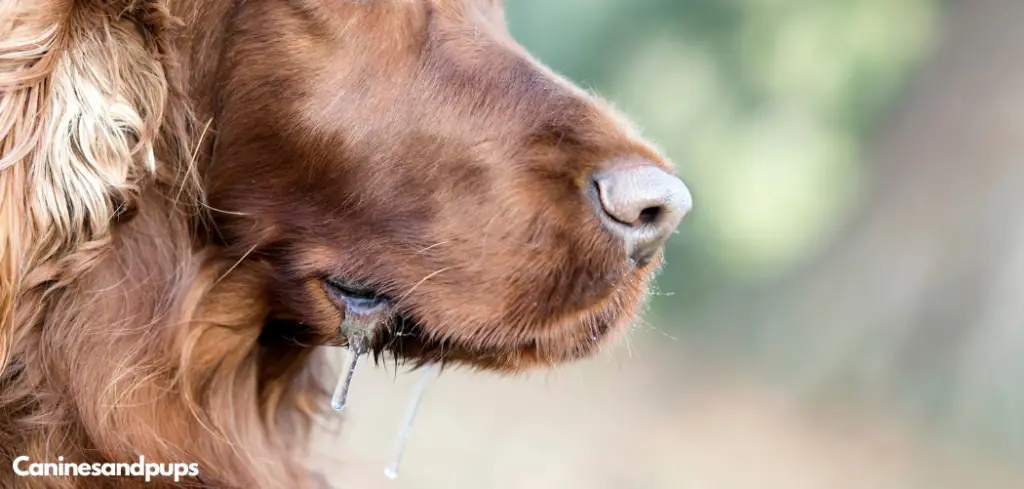It can be alarming to see your dog panting heavily and drooling at the same time. While occasional panting and drooling may be normal, excessive or persistent symptoms could indicate an underlying health issue.
We outline the common causes of a dog panting excessively and drooling, what you can do at home, and when to seek veterinary help.
Table of Contents
Dog Panting Excessively and Drooling — Why It Happens
Excessive panting paired with drooling in dogs is often a sign that something is stressing the body — physically, emotionally, or medically. This combination of symptoms can stem from overheating, anxiety, dental disease, nausea, or even exposure to toxins.
Some dogs may also drool excessively when they’re in pain or experiencing a medical emergency, such as bloat or heatstroke.
Since many of these causes require quick action, it’s important to understand what might be behind your dog’s symptoms.

Common Causes of Dog Panting Excessively and Drooling
Heatstroke
Heatstroke is one of the most serious causes of panting and drooling in dogs, especially in hot weather or after exercise.
Dogs cool themselves by panting, but when temperatures soar or they can’t regulate their body heat effectively, they may pant more rapidly and begin drooling excessively.
Other signs include red gums, vomiting, collapse, or seizures.
Heatstroke is a medical emergency and can be fatal without urgent care.
Read more: Dog Panting Excessively and Restless (Here’s why it could be serious)
Anxiety or Stress
Dogs that are scared, anxious, or stressed often pant heavily and may drool at the same time.
Triggers can include thunderstorms, fireworks, travel, or separation anxiety. You may also notice pacing, whining, hiding, or trembling.
While not always dangerous in the moment, chronic anxiety can negatively impact your dog’s health over time.
Dental or Oral Problems
Mouth pain from issues like dental disease, broken teeth, or oral infections can lead to both drooling and panting.
Dogs with oral discomfort may refuse food, chew on one side, or paw at their mouth.
Untreated dental disease can progress to infections that affect other organs, so it’s important not to overlook oral symptoms.
Nausea or Gastrointestinal Upset
Dogs that feel nauseous may drool excessively and pant due to discomfort.
This could be caused by dietary indiscretion (eating something they shouldn’t), gastrointestinal disorders, or more serious conditions like pancreatitis.
You may also see signs like lip-smacking, vomiting, loss of appetite, or lethargy.
Toxin Ingestion
Ingesting toxic substances — such as household cleaners, certain plants, or human medications — can cause immediate drooling and panting.
This is often accompanied by vomiting, shaking, or seizures, depending on the toxin.
Toxin exposure is a critical emergency and requires fast veterinary intervention.
Read more: Dog Panting Excessively (Here’s why)
Bloat (Gastric Dilatation-Volvulus)
Bloat is a life-threatening condition in which a dog’s stomach fills with gas and may twist, cutting off blood supply.
Dogs with bloat often pant, drool, retch without vomiting, and show signs of distress or abdominal pain.
This condition is most common in large, deep-chested breeds and is always a medical emergency.
What to Do If Your Dog Is Panting Excessively and Drooling
If your dog is panting and drooling heavily, bring them into a cool, quiet area immediately. Make sure they have access to fresh water but avoid forcing them to drink.
Observe your dog for any additional symptoms like vomiting, collapse, or unresponsiveness.
Avoid giving any medications unless prescribed by your vet, as some human medications can worsen the situation.
If anxiety seems to be the cause, gently comfort your dog, reduce noise and stimulation, and consider speaking with your vet about calming products or behavior training.
For dental concerns or nausea, a veterinary exam is needed to determine the root cause and begin treatment.
When to Call or Visit Your Vet
Contact your vet right away if your dog:
Pants and drools persistently for more than 10–15 minutes without an obvious trigger
Has pale or blue gums
Collapses, seems disoriented, or struggles to breathe
Has a bloated or painful abdomen
Shows signs of toxin ingestion (tremors, vomiting, seizures)
Has ongoing symptoms even in a cool environment
Rapid intervention is critical for heatstroke, bloat, and toxic reactions.
Read more: Dog Panting Excessively and Drinking Lots of Water (What it means)
Key Takeaway
Excessive panting and drooling in dogs are red flags that shouldn’t be ignored — especially if they occur suddenly or without an obvious cause.
While some cases are related to stress or dental issues, others may indicate life-threatening emergencies like bloat or heatstroke.
When in doubt, always err on the side of caution and consult your veterinarian.
With early action and supportive care, many dogs recover well and stay safe.
